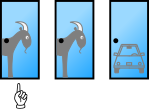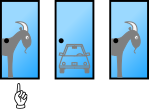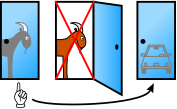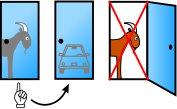User:Martin Hogbin/conditionalsection
Draft[edit]
Conditional probability solution[edit]
Conditional probability can be used to solve the Monty hall problem(Selvin 1975b; Morgan et al. 1991). Consider the mathematically explicit version of the problem given above . The probability the car is behind any door can be analyzed both before and after the host opens a door. The probability the car is behind any one of the doors before the host opens a door is 1/3. Assuming the player picks Door 1 and the host then opens Door 3, the probability of winning by switching is the probability the car is behind Door 2 given the condition that the host opens Door 3, generally written:
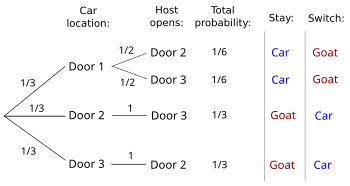
This probability can be computed using Bayes' Theorem (see below), or directly from the figure below or a decision tree as shown to the right (Chun 1991; Grinstead and Snell 2006:137-138 presents an expanded tree showing all initial player picks). Referring to either the figure or the tree, the case that the host opens Door 3, and the car is behind Door 2 has probability 1/3 but the case that the host opens Door 3, and the car is behind Door 1 has probability 1/6. The sum of these probabilities is 1/2, as the host opens Door 3 half of the time. The conditional probability the car is behind Door 2 given the player has picked Door 1 and the host opens Door 3 is defined as the probability the car is behind Door 2 in the cases the host opens Door 3 (1/3) divided by the probability of all cases where the host opens Door 3 (1/2), therefore the conditional probability is (1/3)/(1/2)=2/3.
Mathematical formulation [as in the article]


